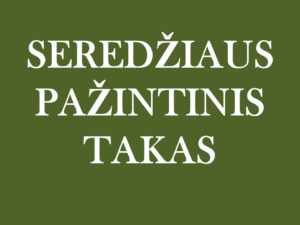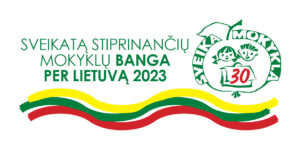2. THE SHOOTING RANGE
The shooting range was set upin the place where Seredžius Barracks (architect Algirdas Šalkauskis) were established in 1935-1936. Shooting exercises and competitions used to take place there, revolvers and other arms were used then. In the Soviet era, school students learned the line arrangement exercises and shooting at the ready targets during the military preparation lessons. After regaining independence, there are various events taking place here: minifootball is played, the youth music celebrations are organized and St. John‘s day is celebrated.
3. THE VIEWPOINT
Seredžius is located on the right bank of the Nemunas River,
between the Dubysa and the Armena rivers, near the picturesque road Kaunas –
Jurbarkas – Klaipėda.
The first settlement in the area has been settled a long time ago and there is
no exact knowledge of it. At the confluence of the Nemunas and the Dubysa
people have been inhabited since the Stone Age. Archaeological excavations have
found Neolithic work tools and tombs from the 5th to 7th centuries. According to
written sources, the area was first mentioned during the Lithuanian battles
with the Crusaders. Along the Nemunas River new castles were built and
fortified, which formed a united defense system.
Bridges of Seredžius. In the summer of 1944, the old concrete Seredžius Bridge with metal bows was blown up by retreating German troops. It was soon replaced by a wooden bridge over the Dubysa, which had been used before the new bridge was built in 1972.
The Nemunas
is the longest river in Lithuania. Its total length is 937 km, while in the
territory of Lithuania it flows 359 km. On the other side of the Nemunas there
is Kriūkai town of Šakiai district.
The Dubysa
is a right tributary of the Nemunas. Its length is 146 km. It separates the
districts of Jurbarkas and Kaunas. Seredžius town is located at the picturesque
confluence of the the Nemunas and the Dubysa.
4. THE THREE-PINE PLACE
This square overlooks Seredžius Township, Old Cemetery and St. John the Baptist Church.Our school graduates used to greet the sun here.On the three pinehillside grow plants included in the Red Book: meadow sage, blue gentian, snowdrop anemone. The prickly plum shrubs characteristic only to this area can be detected here.
5.THE PARK
The Park was started during the lifetime of Seredžius Manor. This is evidenced by the survival of old trees: oaks, poplars, limes. During the Barracks period (1934-1940) the park was expanded and other trees were planted: sycamore, acacia, larch, maple, ash, chestnut trees. At that time there were tulip-shaped flowerpot vasesinstalled on the stairs and a large decorative mushroom designed near the building. After the school was established here in the post-war period, the park was full of thuja, walnut trees and ornamental shrubs. The park is rich in various herbaceous plants: common and sloping strawberries, sheep fescues, common carlinthistles, notrels, celandines. Inspringvioletsand forget-me-nots bloom on the slopes. Pigeons, Eurasian collared doves, green woodpeckers, flycatchers, robin redbreasts, fieldfares and other birds hatch in park trees. Squirrels, creeping lizards, grapevinesnails and various types of butterflies are often seen here. The slope of the park descends with terraces, and the stairs installed here in the interwar period were renovated in 1988.
6. THE BIG OAK
It is supposed that this oak could have been planted in the 18century during the life of the Seredžius estate. It is an exclusive tree in the park. It is believed to be about 200 yearsold, anditsheight is about 50 metres. The oak trunk can only just be enclasped by four older children of school age. According to our ancestors, oak is the most powerful antidote for treating various diseases. Trees can not root out and flee where it is better. Having firmly injected the roots into the land of ancestors, they remind us mutely where the real centre of the world is. Oaks live long, but they are not eternal. And when an oak tree is abandoned by life, it canstart talking again in the hands of a diligent person, for thisoneonlyneeds a heartand a talent. Wooden sculptures that decorate the environment of our town, express love for the Lithuanian ethnoculture and respect for old traditions.
7. THE SCHOOL SCULPTURE PARK
The park was launched in 2006 by the Woodcarving Plein-airs, which led to the participation of professional sculptors and school students, their parents and residents of Seredžius town. 5 sculptures – „Fisherman“,“Owlet“, “ Life“, „Girl with Sunflowers“ and“Owl“ were created in 2006. Their author is Linas Saladis, the sculptor. Later, the carving was led by sculptor Algimantas Sakalauskas. In 2012, a memorial sculpture was built for Stasys Šimkus. The Palemonas Thronewas created in 2014. The sculpture „Kur Bakūžė Samanota“ was built in 2017 and it is dedicated to mark the international Stasys Šimkus Choir Festivals.
8. THE PALEMONAS THRONE
The PalemonasThrone was created and built in the summer of 2014. School students, their parents and Seredžius town inhabitants participated in the carving plein-air. The author of the idea and the head of the works was Algimantas Sakalauskas, the sculptor. Algimantas Sakalauskas is a folk artist,wooden sculptor.Hehasbeen a memberof the Folk Art Association since 1991, the AssociationNorde Lietuva member since 1998 and Director of the Carving centre „Artistic Carving“. He is the author of various sculptures, monuments, crosses, wayside shrines, church and chapel interiors.
9. ST. AGATHA
According to the lives of the saints, Agatha was born into a wealthy family in Sicily. Having accepted the Christian faith, she decided to live in virginity. After refusing to marry a prefect in the city of Catania, she was persecuted under anti-Christian law. She was delivered to a brothel, later thrown into prison. After torture she was burned at the stake. She is believed to protect against fires and all kinds of disasters. Even today, the home is considered to have a celebrated St. Agatha’s bread, which is believed to protect the home from adversity. St. Agatha’s sculpture was built in 2007 at the first school building. Its author is Linas Saladis from Vilkija, the wood carver, folk artist and participant of many symposia in Lithuania. After the gym had been built, Agatha’s sculpture was moved to the main school building. Dressed in a noble robe and having a flower wreath on her head, she holds a loaf of bread to protect against fire. Inscription on the sculpture: “Agatha, the patroness of fire, cover us with your coat.”
10. BEDS OF HERBS AND SPICES
Mint (latin Mentha) isa genus of plants in the familyLamiaceae.Perennial and highly fragrant herb. Helps with digestive problems, colic and stomach acid. Helps with increased nervousness, troublesome insomnia, headaches.
Lemon balm (latin Melissa officinalis) is a plant in the mint family. Often is used in fol medicine to improve mood and suppress indigestion. Externally used melissa extract stops viruses from multiplying. As an aid, the herb is used to suppress the symptoms of Alzheimer’s, activity and attention disorders, anxiety.
Garden or Common sage (latinSalvia officinalis) is a subshrub of the mint family, native to the Mediterranean region.The plant is herbaceous, perennial. Fragrant sage leaves are used in fish, canned food, suitable for use in sauces, meat products, steaks, soups. Also used as a medicinal plant. It has a fragrant essential oil. Decoction of leaves stimulates the secretion glands of the stomach and pancreas, disinfects and suppresses inflammation. It is used to treat angina, chronic tonsillitis, respiratory diseases, oral lesions, radiculitis, osteoporosis, stomatitis, skin lesions, hair loss, etc. When blood pressure rises, it can be lowered by breathing in the aroma of dry sage leaves.
Flax (latin Linum) is a genus in the family Linaceae.Annual and perennial grasses and shrubs. Fruit – box. They have been grown since ancient times, but it is not possible to determine where the primary flax homeland is. Cultivated in Lithuania for more than 4000 years. Flax fiber is used for natural fabrics, linen is three times stronger, five times more abrasion resistant and more shiny than cotton. Linen fabrics do not cause allergic reactions, they are like a natural antiseptic, less dirt, soap and lime deposits. The nutrients in flaxseed can help reduce the risk of diabetes, cancer and heart disease. For this reason, flaxseed is sometimes considered a food used to improve health. Flaxseed contains fiber, healthy fat, protein, various minerals and vitamins.
Rue (latin Ruta) is a genus of subshrubs in the family Rutaceae.There are many species in the genus. The green rue is a perennial, 20-80 centimeters tall, semi-woody plant. The green rue blooms in June and August. Ruth is grown in flower gardens and cemeteries and is widespread throughout the country. It is also advisable to treat myopia, rickets and headaches. Since long it has been advised to drink fresh rue juice after being bitten by an insect or a snake. It is advisable to drink this juice in case of visual impairment. Attention! Rue can burn the skin. Rue established itself in Lithuania as a symbol of chastity. Only a virgin, who is unmarried, can only dress up or wear a wreath of rue. Young girls dress up in rue when they accept their first communion. When a young person dies, the coffin is also decorated with rue. This plant is important in local Lithuanian folklore and customs.
Oregano (latin Origanum vulgare) is a plant in the family Lamiaceae. Ornamental, melliferous, spice and medicinal plant. Oregano preparations have a calming, sweating, expectorant, urinary and biliary secretion, antispasmodic, antiseptic, anti-inflammatory and analgesic effect. Oregano herb is used as a soothing and spasmolytic remedy for nervous system irritation, insomnia, headaches. Oregano is a natural antiseptic.








